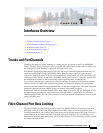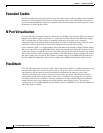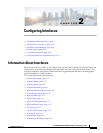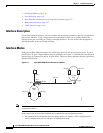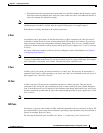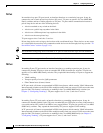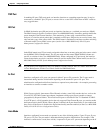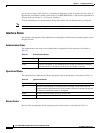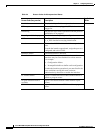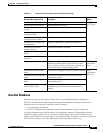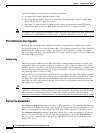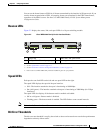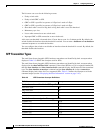
2-5
Cisco MDS 9000 Family NX-OS Interfaces Configuration Guide
OL-29284-01, Release 6.x
Chapter 2 Configuring Interfaces
Information About Interfaces
TNP Port
In trunking NP port (TNP port) mode, an interface functions as a trunking expansion port. It may be
connected to a trunked F port (TF port) to create a link to a core NPIV switch from an NPV switch to
carry tagged frames.
SD Port
In SPAN destination port (SD port) mode, an interface functions as a switched port analyzer (SPAN).
The SPAN feature is specific to switches in the Cisco MDS 9000 Family. It monitors network traffic that
passes though a Fibre Channel interface. This monitoring is done using a standard Fibre Channel
analyzer (or a similar switch probe) that is attached to an SD port. SD ports do not receive frames, they
only transmit a copy of the source traffic. The SPAN feature is nonintrusive and does not affect switching
of network traffic for any SPAN source ports (see the Cisco MDS 9000 Family NX-OS System
Management Configuration Guide).
ST Port
In the SPAN tunnel port (ST port) mode, an interface functions as an entry point port in the source switch
for the RSPAN Fibre Channel tunnel. The ST port mode and the remote SPAN (RSPAN) feature are
specific to switches in the Cisco MDS 9000 Family. When configured in ST port mode, the interface
cannot be attached to any device, and thus cannot be used for normal Fibre Channel traffic (see the Cisco
MDS 9000 Family NX-OS System Management Configuration Guide).
Note ST port mode is not supported on the Cisco MDS 9124 Fabric Switch, the Cisco Fabric Switch for HP
c-Class BladeSystem, and the Cisco Fabric Switch for IBM BladeCenter.
Fx Port
Interfaces configured as Fx ports can operate in either F port or FL port mode. The Fx port mode is
determined during interface initialization depending on the attached N port or NL port. This
administrative configuration disallows interfaces to operate in any other mode—for example, preventing
an interface to connect to another switch.
B Port
While E ports typically interconnect Fibre Channel switches, some SAN extender devices, such as the
Cisco PA-FC-1G Fibre Channel port adapter, implement a bridge port (B port) model to connect
geographically dispersed fabrics. This model uses B ports as described in the T11 Standard FC-BB-2.
If an FCIP peer is a SAN extender device that only supports Fibre Channel B ports, you need to enable
the B port mode for the FCIP link. When a B port is enabled, the E port functionality is also enabled and
they coexist. If the B port is disabled, the E port functionality remains enabled (see the Cisco MDS 9000
Family NX-OS IP Services Configuration Guide).
Auto Mode
Interfaces configured in auto mode can operate in one of the following modes: F port, FL port, E port,
TE port, or TF port. The port mode is determined during interface initialization. For example, if the
interface is connected to a node (host or disk), it operates in F port or FL port mode depending on the N



